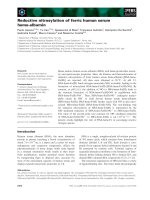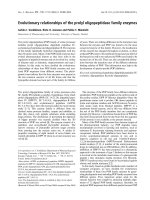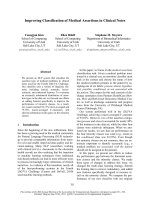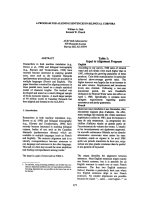Báo cáo khoa học: "Logical Form of Complex Sentences in Task-Oriented Dialogues*" docx
Bạn đang xem bản rút gọn của tài liệu. Xem và tải ngay bản đầy đủ của tài liệu tại đây (235.4 KB, 2 trang )
Logical Form of Complex Sentences
in Task-Oriented Dialogues*
Cecile T. Balkanski
Harvard University, Aiken Computation Lab
Cambridge, MA 02138
Introduction
Although most NLP researchers agree that a level of
"logical form" is a necessary step toward the goal of rep-
resenting the meaning of a sentence, few people agree on
the content and form of this level of representation. An
even smaller number of people have considered the com-
plex action sentences that are often expressed in task-
oriented dialogues. Most existing logical form represen-
tations have been developed for single-clause sentences
that express assertions about properties or
actual
actions
and in which time is not a main concern. In contrast,
utterances in task-oriented dialogues often express
unre-
alized
actions, e.g., (la), multiple actions and relations
between them, e.g., (lb), and temporal information, e.g.,
(lc):
(1) a. What about rereading the Operations
manual?
b. By getting the key and unlocking the gate,
you
get ten points.
c. When the red fight goes off, push the handle.
In the following sections, I discuss the issues that arise
in defining the logical form of these three types of sen-
tences. The Davidsonian treatment of action sentences
is the most appropriate for my purposes because it treats
actions as individuals [7]. For example, the logical form
of "Jones buttered the toast" is a three place predicate,
including an argument position for the action being de-
scribed, i.e., 3x
butter(jones, toast, x).
The presence of
the action variable makes it possible to represent op-
tional modifiers as predications of actions and to refer
to actions in subsequent discourse. Furthermore, and
more importantly for the present purpose, it facilitates
the representation of sentences about multiple actions
and relations between them.
Unrealized-action sentences
A Davidsonian logical form of sentence (la), namely
3x reread(us, manual,
x), makes the claim that there
exists
a particular action x. But this is not the intended
meaning of the sentence. Instead, this sentence con-
cerns a
hypothetical
action. The same problem arises
with sentences (lb) and (lc) which state how
typical
actions are related or when to perform a
future
action.
Apparently, Davidson did not have these types of action
in mind when suggesting his theory of logical form.
In fact, a closer look at the literature shows that
the problem of representing action sentences that do
*This research has been supported by U S West Advanced
Technologies, by the Air Force Office of Scientific Research
under Contract No.AFOSR-89-0273, and by an IBM Grad-
uate Fellowship.
331
not make claims about actions that have or are oc-
curring (i.e., actual actions) has been virtually ignored.
Hobbs, who also adopts a Davidsonian treatment of ac-
tion sentences, is one notable exception [11]. His "Pla-
tonic universe" contains everything that can be spoken
of and the predicate
Exist
is used to make statements
about the existence in the actual universe of individu-
als in the Platonic universe. For example, the formula
Exists(x) Arun'(x, john)
says that the action of John's
running exists in the actual universe, or, more simply,
that John runs. The approach I am currently investi-
gating is to extend Itobbs' representation by introduc-
ing predicates stating the existence of actions in future,
hypothetical or typical worlds as well as in the actual
world.
Another possibility is to adopt the standard philo-
sophical approach to the representation of properties,
and for that matter, of actions, that are not actually
instantiated, namely possible worlds (cf. [13, 2]). Fur-
thermore, and independently of the approach that is
adopted, there is a need to identify the different
types
of unrealized actions and determine whether they should
be distinguished in the logical form.
Multi-clause sentences
Another area of logical form that has not received much
attention is the representation of sentences about multi-
ple actions and relations between them. I have been
investigating sentences including by- and to- purpose
clauses because they are used to communicate two ac-
tion relations, namely generation and enablement, which
I have defined elsewhere [3]. In a Davidsonian logical
form, the connectives "by" and "to" can be represented
as two-place predicates ranging over action tokens1; e.g.:
(2) To learn how to use the system, read the manual.
learn(you, system, xa )
A
read(you, manual,
x2)A
inorderto(x2, xa)
Clauses may also be joined with coordination con-
junctions, e.g., (3a), and the resulting constituent may
participate in another action relation, as in (lb) and
repeated below in (3b). I therefore represent these con-
neetives by a three place predicate, e.g.,
and(xl,
x2, x4)
which is true if action x4 is the conjunction of actions
xl and x2. In (3a), the action token x4 might seem
superfluous, but note that it becomes necessary if that
action is referred to in subsequent discourse (e.g., "Do
aAlthough this problem interacts with the one discussed
in the previous section, for the purpose of this presentation,
I call Davidson's action variables
action tokens
and represent
them as constants in the logical form.
it fast!"); in (3b), the action token z4 can then be used
as the first argument to the by predicate:
(3) a. Get the key and unlock the gate.
get(you, key, xl ) ^ unZock(yo,,, gate, x2 )^
and(xl, x2, x4)
b. By getting the key and unlocking the gate, you
get ten points.
get(you, key, xl) ^
unlock(you, gate,
z2)^
get(you, lOpoints,
z3) ^
and(z1,
z2, z4) ^
by(x4,
za)
In the above logical forms, I assume that the by and
inorderto predicates denote a two place relation express-
ing the "ideal meaning" of the corresponding English
connective [9]. There is not necessarily a one-to-one
mapping between particular linguistic expressions and
action relations, and subsequent pragmatic processing
of the logical forms will further interpret these relations.
Representing the embedded clause as an additional ar-
gument to the predicate representing the matrix clause
(e.g., [5]), or representing the relation as a binary sen-
tential operator (e.g., [16]) are alternative representa-
tions, both of which suffer from problems discussed by
Davidson because action tokens become irrelevant. Fur-
thermore, the first does not capture the intuitive notion
that these sentences express action relations, and the
second introduces a lack of homogeneity between logical
forms of sentences involving action relations and those
that do not.
Time
Still another feature that has been overlooked in the
study of logical form is time. Although a number of pa-
pers include time in their logical forms, most do not dis-
cuss their treatment of time and consider primarily past
and present tense examples about actual actions (e.g.,
[1, 5, 1412). The lack of concern for temporal issues is
also characteristic of the literature on semantic interpre-
tation (e.g., [10, 15, 16]). On the other hand, there is a
vast literature on the interpretation and representation
of tense, aspect and temporal modifiers, but these pa-
pers do not describe the logical forms from which their
representations are generated (e.g., [4, 6, 8, 12, 17, 18]).
Clearly, there is a missing link between the literature
on logical form and that on tense and aspect. Providing
such a link is one of the goals of this research. David-
son's treatment of action sentences does not provide a
fully satisfying starting point. Although his initial pa-
per does not include any example of temporal modi-
fiers, he would probably represent them as predicates
over action tokens, e.g., next_week(x), a representation
that does not make explicit reference to time (to which
anaphors might refer). Introducing a time predicate,
e.g., time(z, next_week), solves this particular problem,
but introduces other complexities because this predicate
would not be adequate for all temporal modifiers (e.g.,
compare Sue will leave in two hours and Sue reached the
top in two
hours). Given that the aspectual type and
tense of the verb, along with the presence of adverbials
and common sense knowledge all interact in the inter-
pretation of the temporal information in a sentence [12],
it might be preferable for such reasoning to be performed
with the logical form as input rather than as output.
2Moore
[14] addresses time issues, but omits future tense
sentences
and acknowledges problematic interactions be-
tween his
event abstraction
operator and time.
Conclusion
Although many researchers have proposed formalisms
for simple action sentences, very few of them have ad-
dressed the issues that arise when extending those for-
malisms to the more complex sentences that occur in
task-oriented dialogues. There has been work in each of
the above areas, but this research has been fragmentary
and still needs to be integrated with that on the logi-
cal form of action sentences. Ironically, the conclusion
that Moore arrived at, ten years ago, is still valid today
[14]: "If real progress is to be made on understanding
the
logical form of natural-language utterances, it must
be studied in a unified way and treated as an important
research problem in its own right." In ray talk, I will
present an initial attempt to do so.
References
[1] H. Alshawi & J. van Eijck. Logical form in the core
language engine. Proceedings of
the
ACL, 1989.
[2] D. Appelt. Planning English referring expressions.
Artificial Intelligence 26, 1985.
[3] C. Balkanski. Modelling act-type relations in col-
laborative activity. Technical Report TR-23-90,
Harvard University, 1990.
[4] M. Brent. A simplified theory of tense represen-
tations and constraints on their composition. Pro-
ceedings of
the
ACL, 1990.
[5] L. Creary. NFLT: A language of thought for rea-
soning about actions, 1983. working paper.
[6] M. Dalrymple. The interpretation of tense and as-
pect in English. Proceedings of the ACL, 1988.
[7] D. Davidson. The logical form of action sentences.
In N. Rescher (ed), The Logic of Decision and Ac-
tion. University Pittsburgh Press, 1967.
[8] M. Harper & E. Charniak. Time and tense in en-
glish. Proceedings of the ACL, 1986.
[9] A. Herskovits. Language and Spatial Cognition.
Cambridge University Press, 1986.
[10] G. Hirst. Semantic interpretation and ambiguity.
Artificial Intelligence, 34, 1988.
[11] J. Hobbs. OntologicM promiscuity. Proceedings of
the
ACL, 1985.
[12] M. Moens & M. Steedman. Temporal ontology
and temporal reference. Computational Linguistics,
14(2), 1988.
[13] R. Moore. A formal theory of knowledge and action.
In J. Hobbs & R. Moore (eds), Formal Theories of
Commonsense Word. Ablex, 1985.
[14] R. Moore. Problems in logical form. Proceedings of
the ACL, 1981.
[15] M. Pollack & F. Pereira. An integrated framework
for semantic and pragmatic interpretation. Proceed-
ings of the ACL, 1988.
[16] L. Schubert & F Pelletier. From English to logic:
Contex-free computation of 'conventional' logical
translations. Computional Linguistics, 10, 1984.
[17] B. Webber. Tense as discourse anaphor. Computa-
tional Linguistics, 14(2), 1988.
[18] K. Yip. Tense, aspect, and the cognitive represen-
tation of time. Proceedings of IJCAI, 1985.
332









